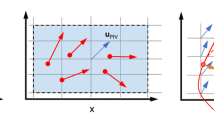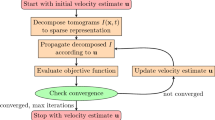Abstract
This paper describes the principles of a novel 3D PIV system based on the illumination, recording and reconstruction of tracer particles within a 3D measurement volume. The technique makes use of several simultaneous views of the illuminated particles and their 3D reconstruction as a light intensity distribution by means of optical tomography. The technique is therefore referred to as tomographic particle image velocimetry (tomographic-PIV). The reconstruction is performed with the MART algorithm, yielding a 3D array of light intensity discretized over voxels. The reconstructed tomogram pair is then analyzed by means of 3D cross-correlation with an iterative multigrid volume deformation technique, returning the three-component velocity vector distribution over the measurement volume. The principles and details of the tomographic algorithm are discussed and a parametric study is carried out by means of a computer-simulated tomographic-PIV procedure. The study focuses on the accuracy of the light intensity field reconstruction process. The simulation also identifies the most important parameters governing the experimental method and the tomographic algorithm parameters, showing their effect on the reconstruction accuracy. A computer simulated experiment of a 3D particle motion field describing a vortex ring demonstrates the capability and potential of the proposed system with four cameras. The capability of the technique in real experimental conditions is assessed with the measurement of the turbulent flow in the near wake of a circular cylinder at Reynolds 2,700.















Similar content being viewed by others
References
Arroyo MP, Greated CA (1991) Stereoscopic particle image velocimetry. Meas Sci Technol 2:1181–1186
Brücker Ch (1995) Digital-particle-image-velocimetry (DPIV) in a scanning light-sheet: 3D starting flow around a short cylinder. Exp Fluids 19:255–263
Chan VSS, Koek WD, Barnhart DH, Bhattacharya N, Braat JJM, Westerweel J (2004) Application of holography to fluid flow measurements using bacteriorhodopsin (bR). Meas Sci Technol 15:647–655
Coëtmellec S, Buraga-Lefebvre C, Lebrun D, Özkul C (2001) Application of in-line digital holography to multiple plane velocimetry. Meas Sci Technol 12:1392–1397
Elsinga GE, Van Oudheusden BW, Scarano F (2006) Experimental assessment of tomographic-PIV accuracy. In: 13th international symposium on applications of laser techniques to fluid mechanics, Lisbon, Portugal, paper 20.5
Herman GT, Lent A (1976) Iterative reconstruction algorithms. Comput Biol Med 6:273–294
Herrmann S, Hinrichs H, Hinsch KD, Surmann C (2000) Coherence concepts in holographic particle image velocimetry. Exp Fluids 29(7):S108–S116
Hinsch KD (2002) Holographic particle image velocimetry. Meas Sci Technol 13:R61–R72
Hori T, Sakakibara J (2004) High-speed scanning stereoscopic PIV for 3D vorticity measurement in liquids. Meas Sci Technol 15:1067–1078
Huang JF, Zhou Y, Zhou T (2006) Three-dimensional wake structure measurement using a modified PIV technique. Exp Fluids 40:884–896
Kähler CJ, Kompenhans J (2000) Fundamentals of multiple plane stereo particle image velocimetry. Exp Fluids 29:S70–S77
Maas HG, Gruen A, Papantoniou D (1993) Particle tracking velocimetry in three-dimensional flows. Exp Fluids 15:133–146
Mishra D, Muralidhar K, Munshi P (1999) A robust MART algorithm for tomographic applications. Num Heat Transfer Part B 35:485–506
Pan G, Meng H (2002) Digital holography of particle fields: reconstruction by use of complex amplitude. Appl Opt 42:827–833
Pereira F, Gharib M, Dabiri D, Modarress D (2000) Defocusing digital particle image velocimetry: a 3-component 3-dimensional DPIV measurement technique. Exp Fluids 29(7):S78–S84
Pu Y, Meng H (2000) An advanced off-axis holographic particle image velocimetry (HPIV) system. Exp Fluids 29:184–197
Scarano F, Riethmuller ML (2000) Advances in iterative multigrid PIV image processing. Exp Fluids 29:S51–S60
Scarano F, David L, Bsibsi M, Calluaud D (2005) S-PIV comparative assessment: image dewarping + misalignment correction and pinhole + geometric back projection. Exp Fluids 39:257–266
Scarano F, Elsinga GE, Bocci E, Van Oudheusden BW (2006) Investigation of 3-D coherent structures in the turbulent cylinder wake using Tomo-PIV. In: 13th international symposium on applications of laser techniques to fluid mechanics, Lisbon, Portugal, paper 20.4
Schimpf A, Kallweit S, Richon JB (2003) Photogrammetric particle image velocimetry. In: 5th international symposium on particle image velocimetry, Busan, Korea, paper 3115
Schröder A, Geisler R, Elsinga GE, Scarano F, Dierksheide U (2006) Investigation of a turbulent spot using time-resolved tomographic PIV. In: 13th international symposium on applications of laser techniques to fluid mechanics, Lisbon, Portugal, paper 1.4
Soloff SM, Adrian RJ, Liu ZC (1997) Distortion compensation for generalized stereoscopic particle image velocimetry. Meas Sci Technol 8:1441–1454
Tsai RY (1986) An efficient and accurate camera calibration technique for 3D machine vision. In: Proceedings of IEEE conference on computer vision and pattern recognition, Miami Beach, FL, USA, pp 364–374
Verhoeven D (1993) Limited-data computed tomography algorithms for the physical sciences. Appl Opt 32:3736–3754
Watt DW, Conery DG (1993) Computational aspects of optical tomography for fluid mechanics and combustion. In: 3rd ASME symposium on experimental and numerical flow visualization, New Orleans, LA, USA, pp 241–251
Westerweel J, Scarano F (2005) A universal detection criterion for the median test. Exp Fluids 39:1096–1100
Wieneke B (2005) Stereo-PIV using self-calibration on particle images. Exp Fluids 39:267–280
Wieneke B, Taylor S (2006) Fat-sheet PIV with computation of full 3D-strain tensor using tomographic reconstruction. In: 13th international symposium on applications of laser techniques to fluid mechanics, Lisbon, Portugal, paper 13.1
Williamson CHK (1996) Vortex dynamics in the cylinder wake. Annu Rev Fluid Mech 28:477–539
Acknowledgments
The authors wish to thank Prof. Dave Watt (University of New Hampshire) and Dr. Dirk Michaelis (LaVision GmbH) for the valuable suggestions on optical tomography and for the software development, respectively.
Author information
Authors and Affiliations
Corresponding author
Rights and permissions
About this article
Cite this article
Elsinga, G.E., Scarano, F., Wieneke, B. et al. Tomographic particle image velocimetry. Exp Fluids 41, 933–947 (2006). https://doi.org/10.1007/s00348-006-0212-z
Received:
Revised:
Accepted:
Published:
Issue Date:
DOI: https://doi.org/10.1007/s00348-006-0212-z




